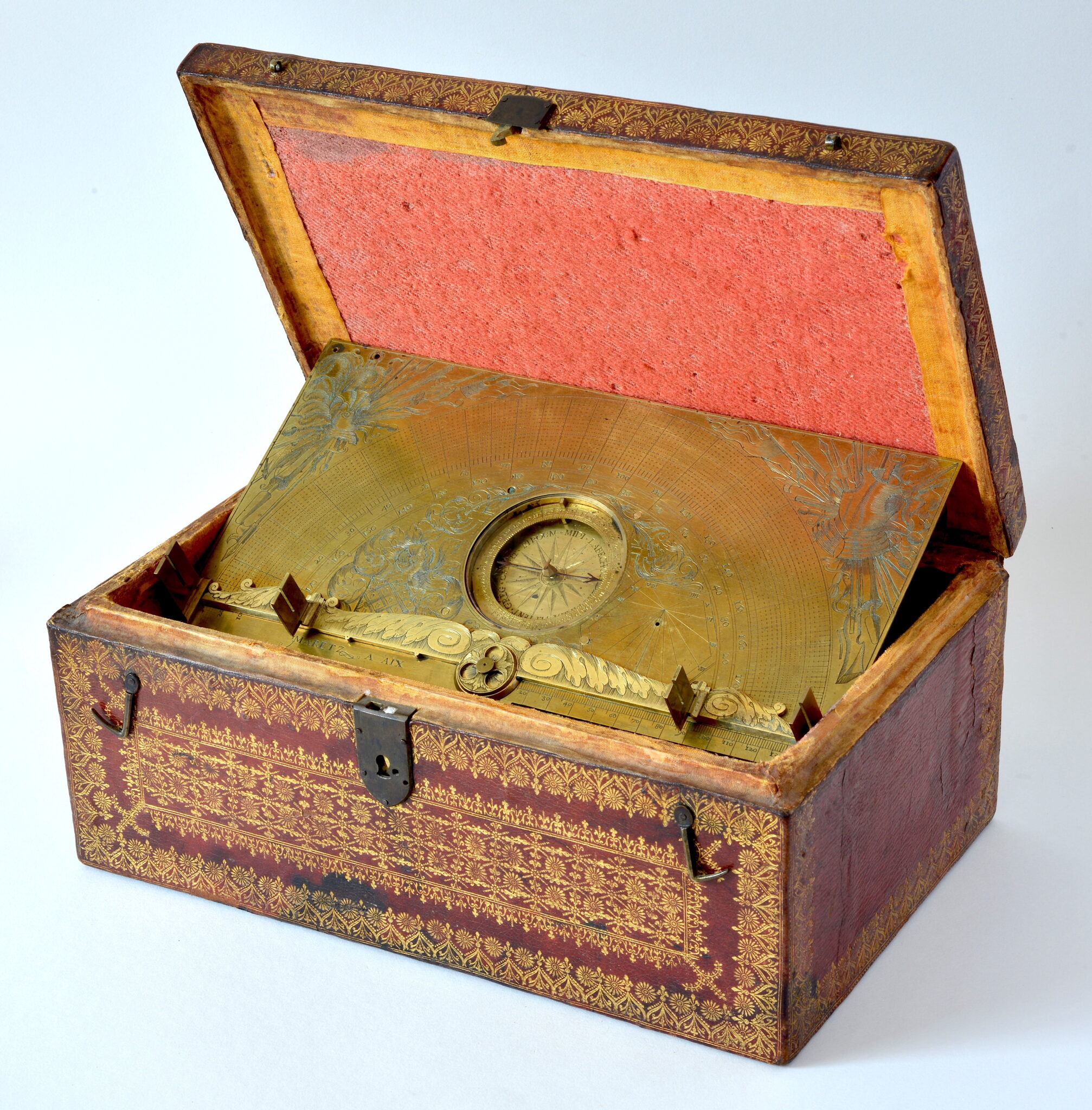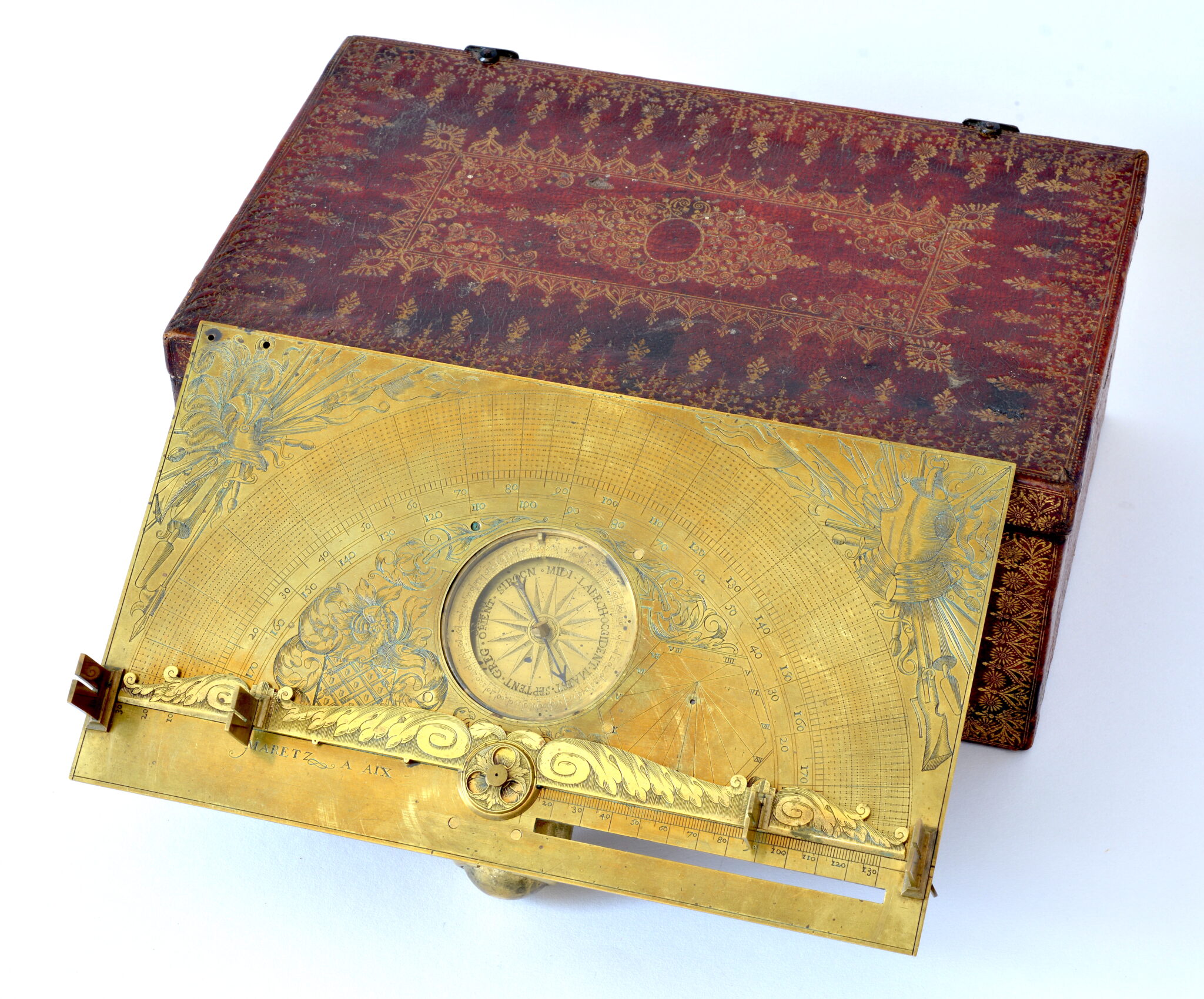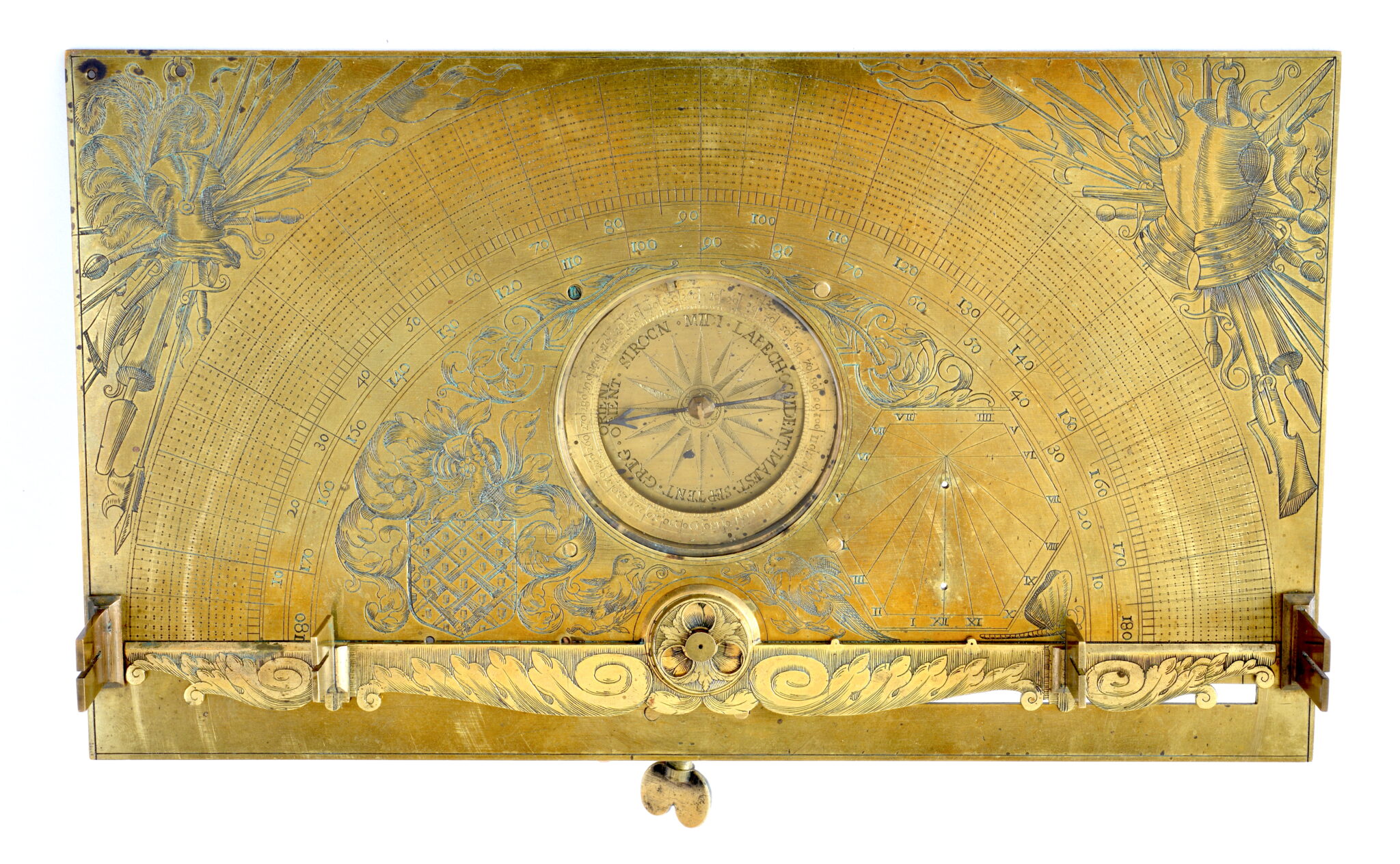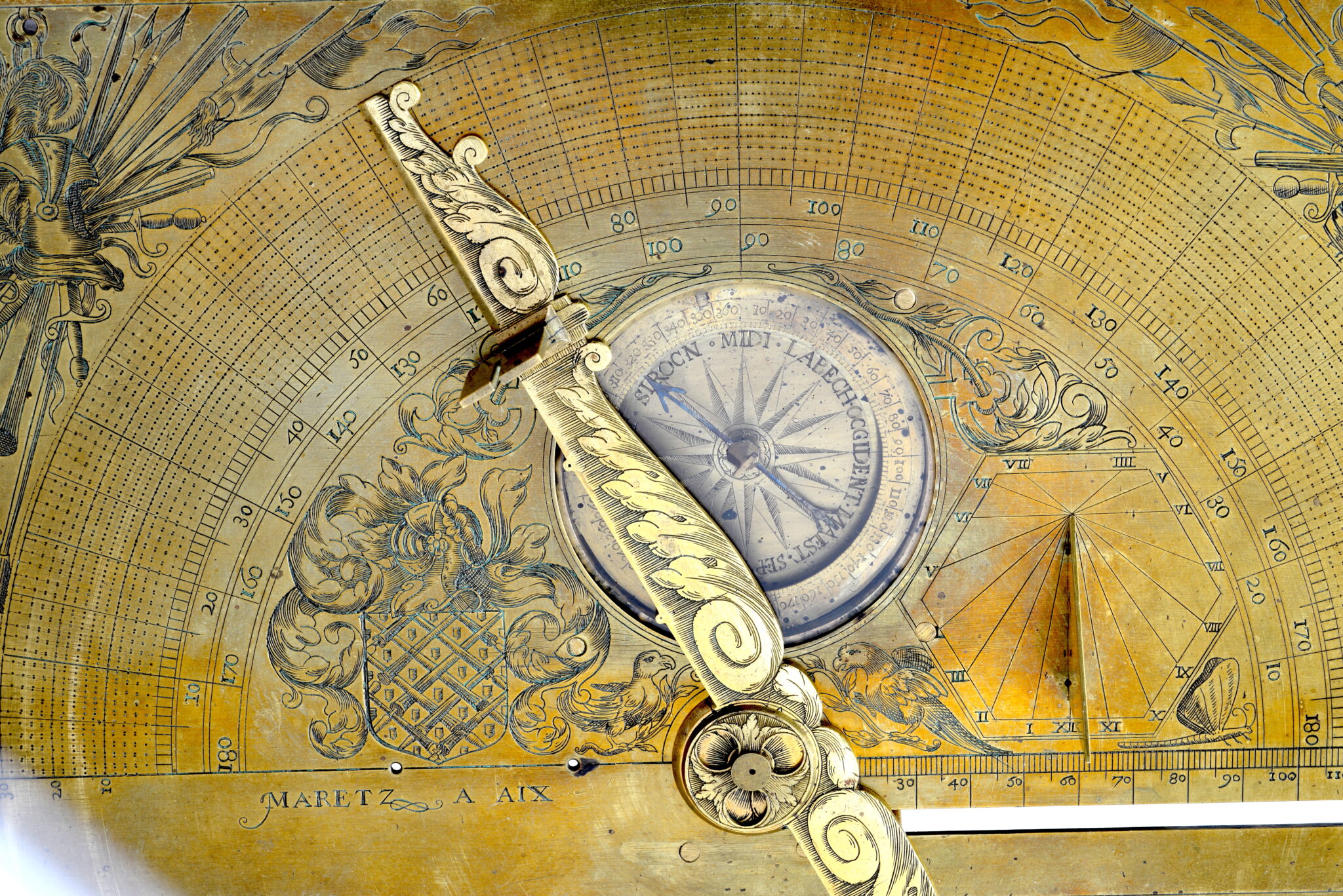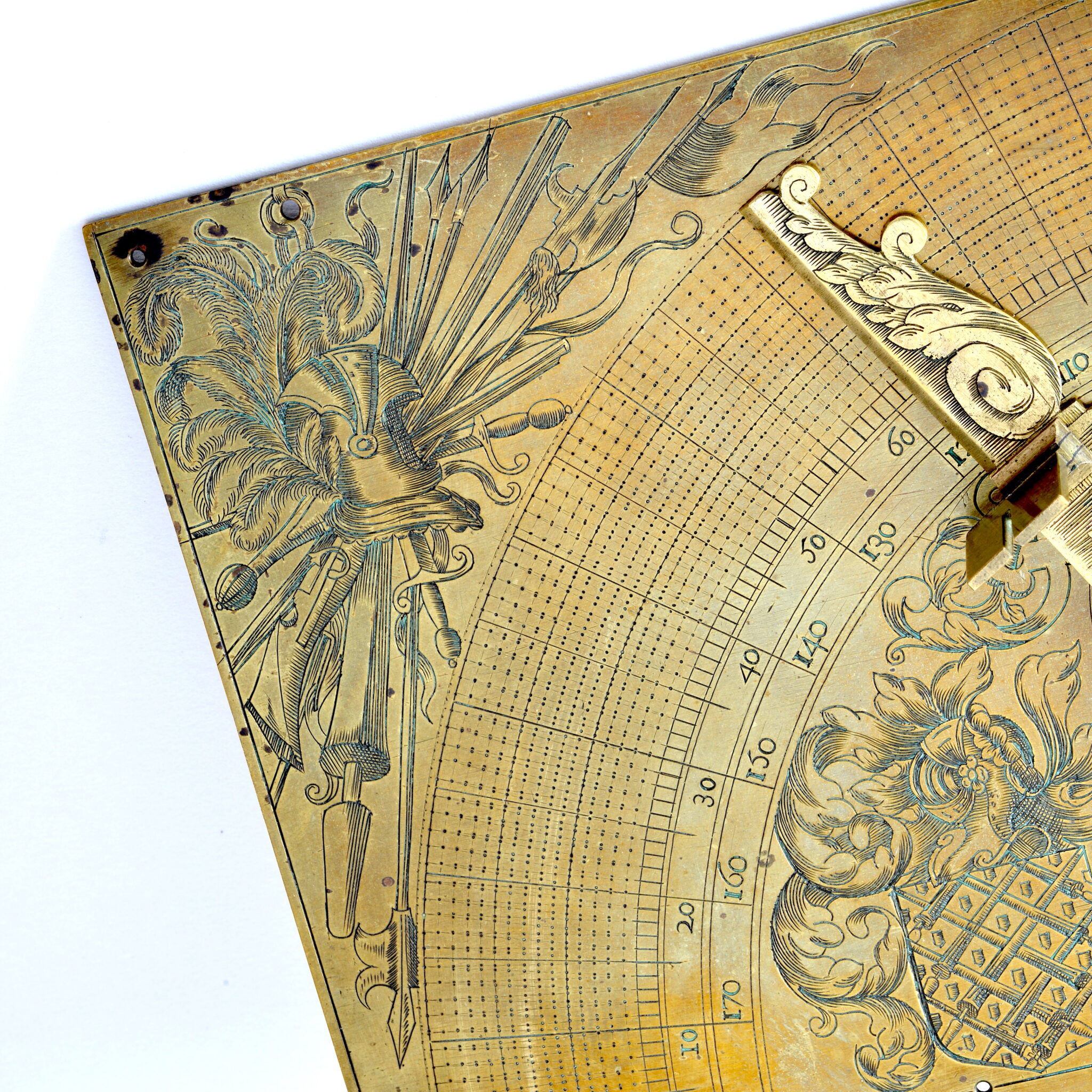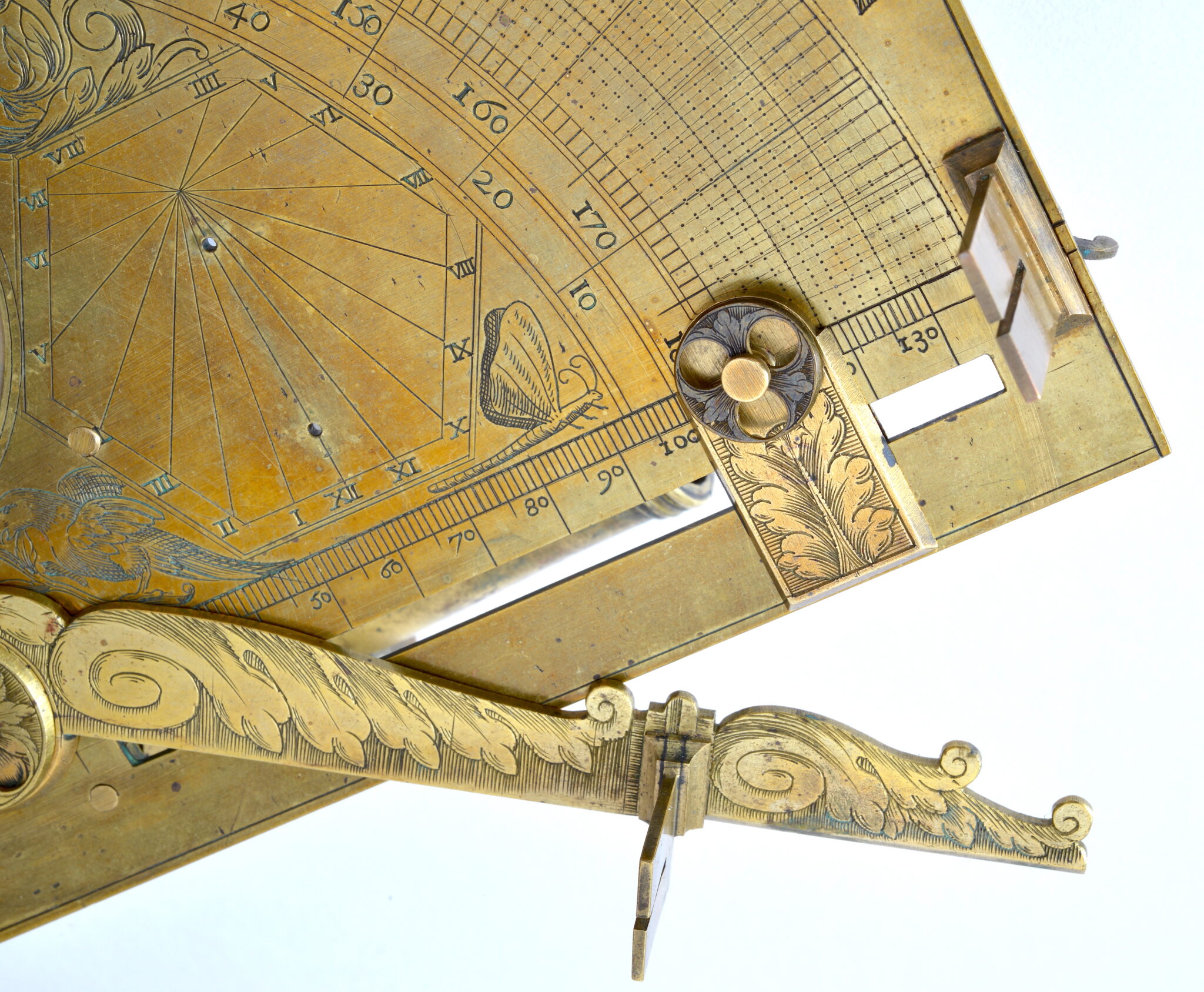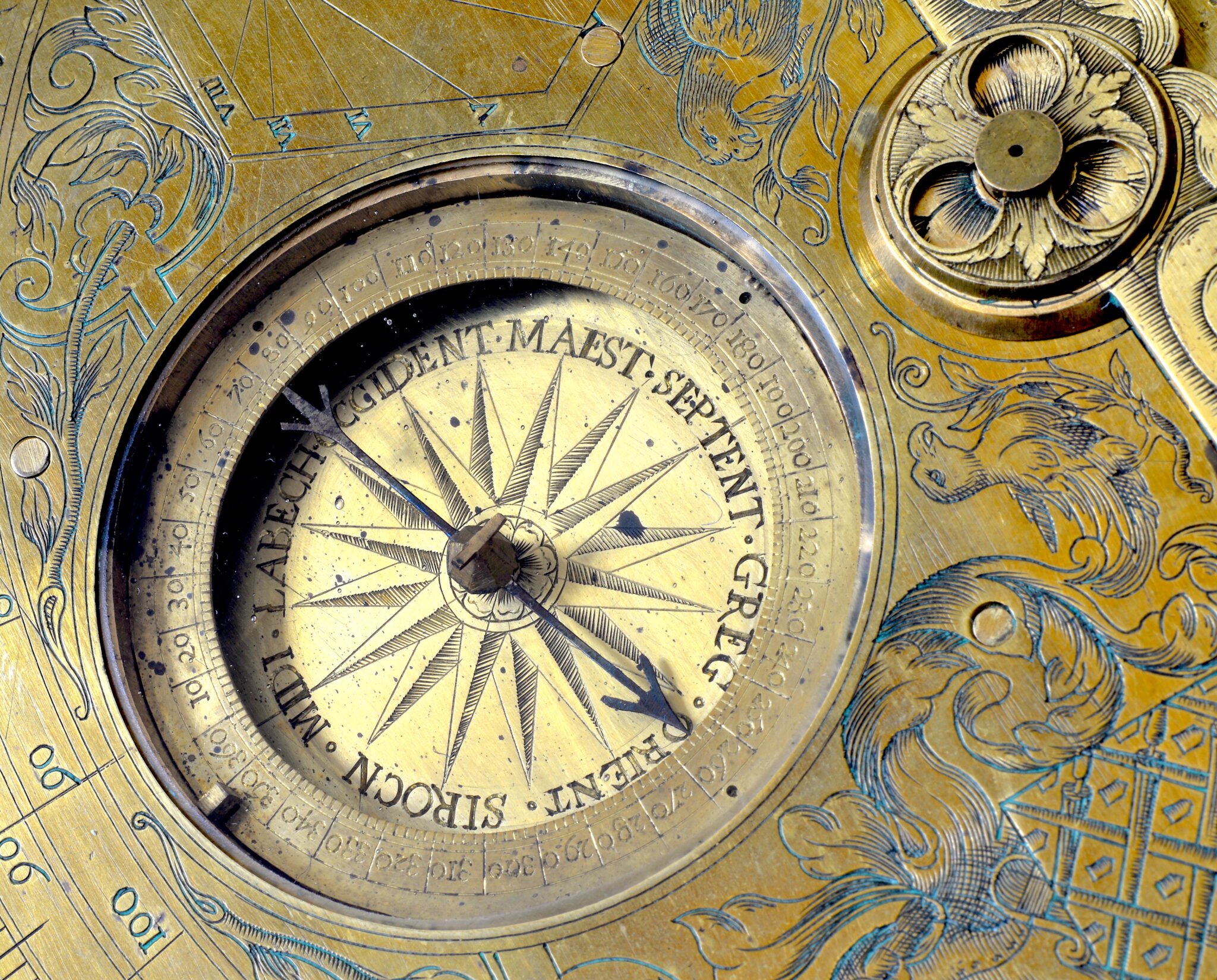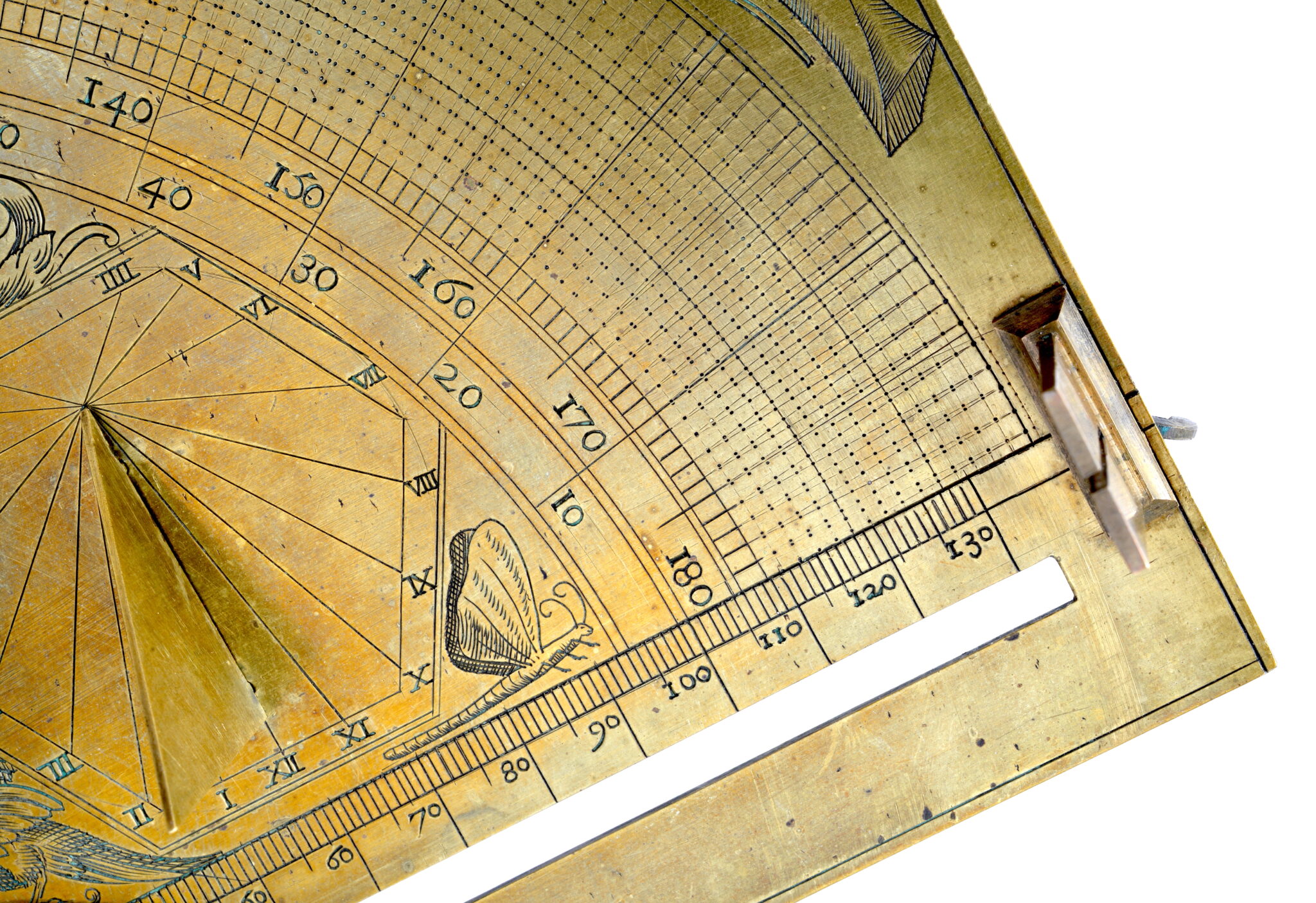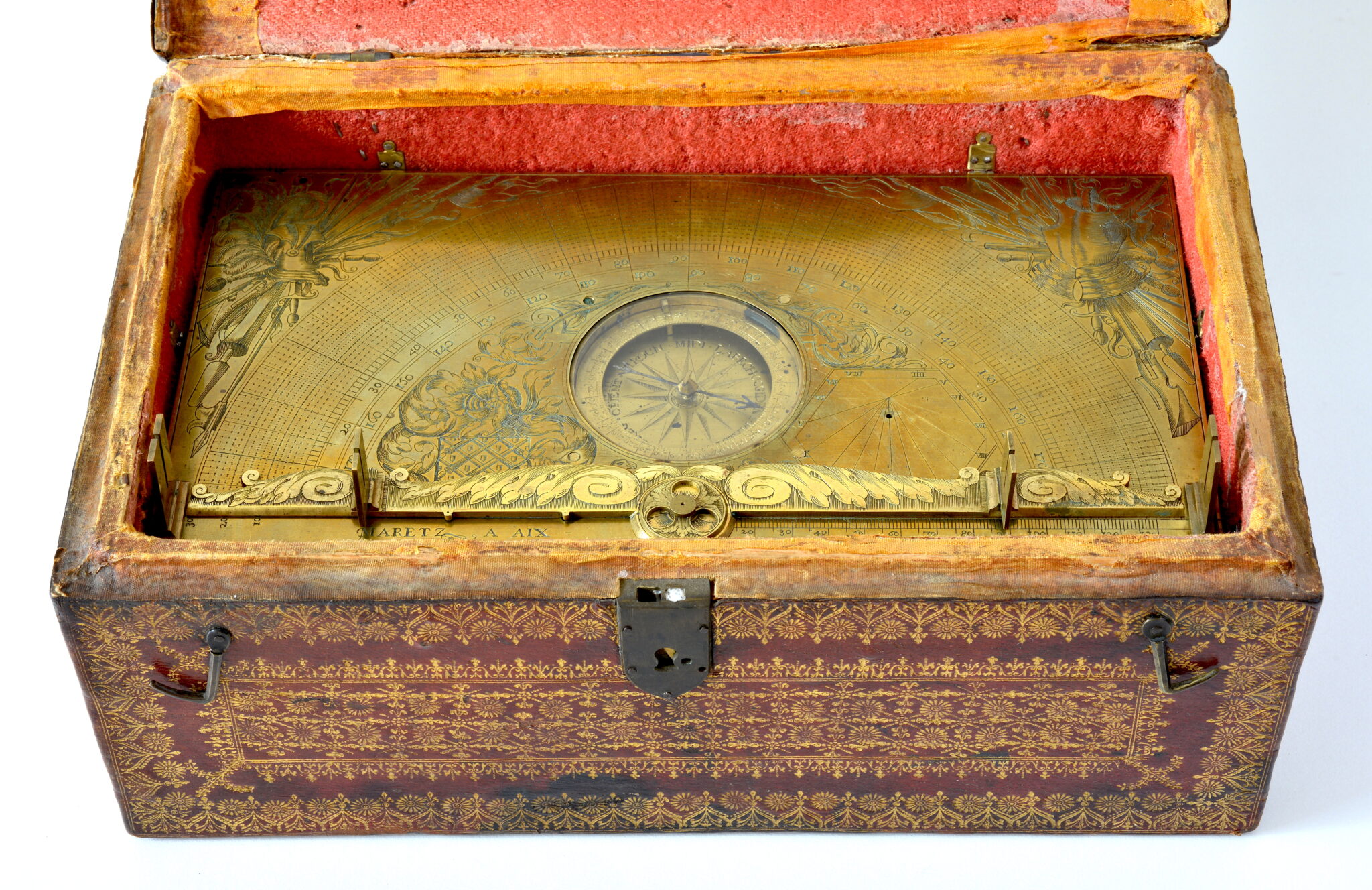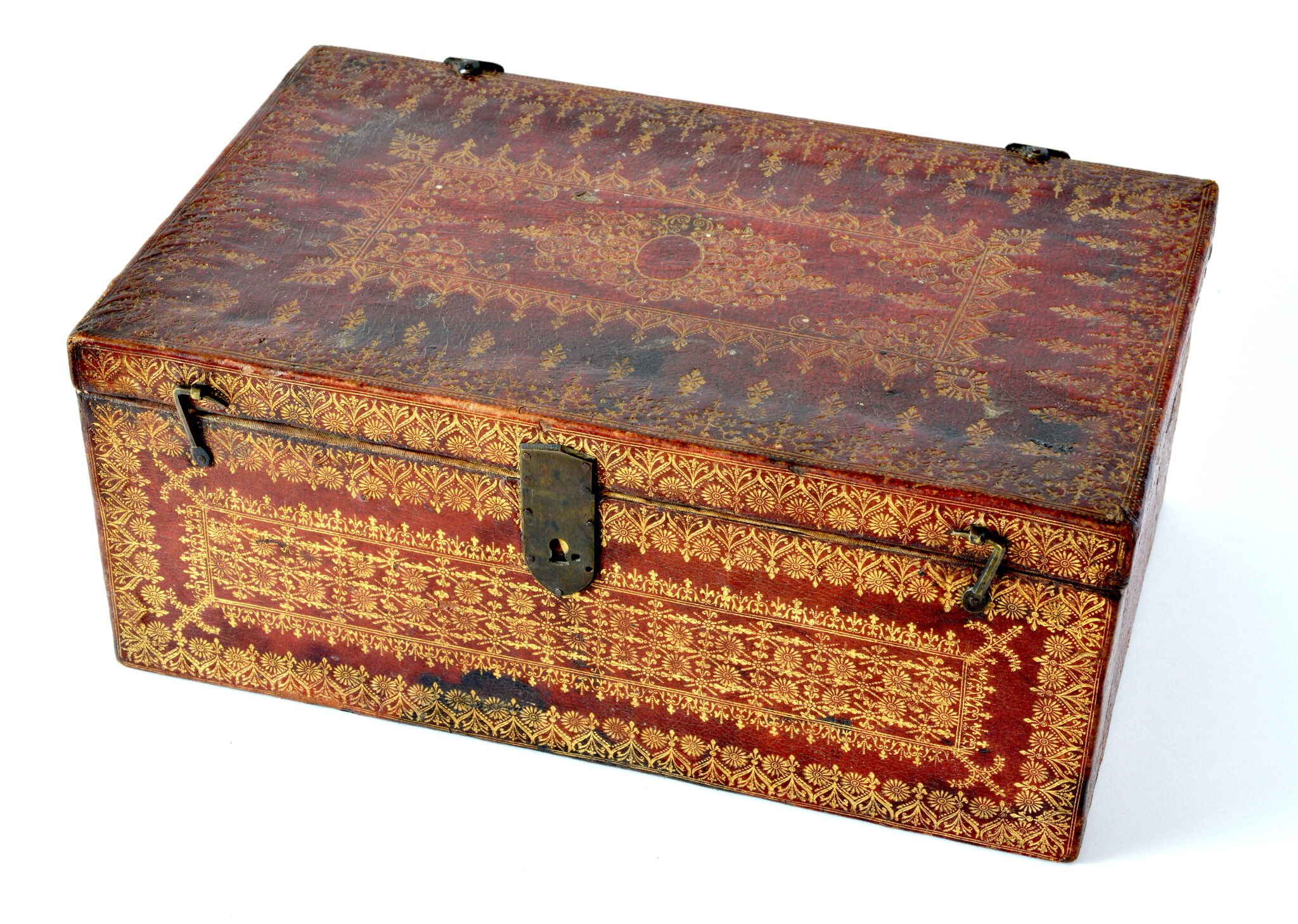Description
Exceptional brass graphometer signed “MARETZ A AIX” in a crimson leather-covered wooden case decorated with gold-tooled floral motifs.
The instrument consists of a rectangular brass plate fitted with a compass, an alidade and a swivel foot. The top of the plate is fully engraved and the set is composed as follows:
– A semi-circle graduated from 0 to 180 degrees in both directions, numbered from 10 to 10, and 15 other scales, made up of dots and double-dots separated by small lines, enable each interval of one degree to be subdivided into intervals of 4 minutes of angle, according to the transverse method but here with remarkable precision. At each end of the base line of the semicircle are sight vanes, fixed by wing nuts.
– A small hole in the center of the base line is used to fix the sighting alidade, using a screw and a wheel-shaped nut. The alidade is entirely decorated with foliate scrolls and has a sight vane at each end.
– Inside the semi-circle is a magnetic compass (5.7 cm in diameter) with its original bubble glass. The pivot-mounted blued steel needle is located just inside the rim of a tablet on which the degrees are engraved, from 0° South to 360°, divided into 2° and numbered by 10. The bottom of the compass is engraved with a 16-direction compass rose with the associated names for 8 directions: SEPTENT. GREG. ORIENT. SIROCN. MIDI. LABECH. OCCIDENT. MAEST. and a small rosette is engraved in the center.
– Below the base line of the semi-circle, on the left, is the signature “MARETZ A AIX” and on the right, a linear scale graduated from 0 to 130 (100 units correspond to 3 inches at the time) with a slot underneath to slide a gauge consisting of a small brass rectangle decorated with an acanthus leaf and fixed with a butterfly screw.
– Beneath the semi-circle, on either side of the compass, is a knight’s coat of arms surrounded by scrolls on the left and a horizontal hexagonal sundial on the right, with two small holes in the center to hold the triangular gnomon, also made of brass. This corresponds to the latitude of 43°30′ i.e., the latitude of Aix-en-Provence. A butterfly is engraved on the right-hand side of the dial, and two branching birds are also engraved below the compass.
– Military trophies are engraved in each upper corner of the plate.
The underside of the plate is unengraved and there is a support with its butterfly screw for the ball-and-socket joint intended to be fixed to a surveyor’s stick. We can also see the back of the compass and the 4 screws used to secure it.
The instrument is housed in a crimson leather-covered wooden case decorated with gold-tooled floral motifs. The interior, comprising 3 lidded compartments, is covered in a pinkish-red fabric that is also found on the inside of the lid. The long, narrow compartment contains the alidade when dismantled. Each of these lids has a pair of brass hinges fastened with small iron nails. The box lid is similarly hinged, with a brass latch controlled by a key (missing) and held in place by a pair of L-shaped brass catches.
Note:
– The angle of the sundial’s gnomon clearly shows that the city inscribed on this instrument is that of Aix-en-Provence. It is a cathedral city and home to the faculties of literature and law of the University of Aix-Marseille. Louis XI established the Parliament of Provence here in 1501, which continued until 1789.
– Study of the town, its inhabitants and its dwellings, was carried out in the 17th century, describing the maker of this surveying instrument. During the first half of the 17th century, Jacques Maretz, a professor of mathematics, geometer and engraver, lived in the rue de Jouques. He wrote a “Plan géométrique de la ville d’Aix” in 1622, and was still alive in 1642. Jacques Maretz published several maps of Provence between 1622 and 1640 (see BnF). It should be noted that the graphometer was invented by Philippe Danfrie (1532-1606), who published a description of it in Paris in 1597
– The present instrument was engraved with great care, skill and knowledge, producing a luxuriously packaged instrument, perhaps for a great civic occasion and destined for a major figure in the region (the coat of arms has not been identified).
Dimensions :
Plate: 25 cm × 14.3 cm
Box: 28 cm x 17 cm x 11.5 cm
France made circa 1630.
NB : lots of high resolution additional photos on request.
Ask the Dealer
Dealer information
Galerie Delalande Paris
After 37 years in Le Louvre des Antiquaires, the Delalande gallery moved early June 2015 to 35 rue de Lille, 75007 Paris, on the other side of the Seine River in the well known antic shops area "le Carré Rive Gauche".
Our main specialties are, since 1976, Marine and Scientific instruments, Tobacco and Opium objects, Curiosities and Great Canes.
We participate to international antique fairs (TEFAF Maastricht) and are unique partner of the French Maritime Museum.
Eric Delalande is also Administrator of the French Experts National Company (C.N.E.).
Please visit also our two websites, which are frequently updated: www.antiquites-delalande.fr (French) and www.delalande-antiques.com (English). ----------------------------
La Galerie Delalande s'est installée en juin 2015 au 35 rue de Lille (75007 Paris), au coeur de la capitale dans le "Carré Rive Gauche", après 37 années de présence au Louvre des Antiquaires.
Nous nous sommes orientés, depuis 1976, vers plusieurs spécialités : Marine et Sciences, Objets du tabac et de l'Opium, Cannes de collection et Curiosités.
Nous participons à des salons d'envergure internationale (TEFAF Maastricht) et sommes partenaires exclusifs du Musée National de la Marine.
Eric Delalande est également Administrateur de la Compagnie Nationale des Experts (C.N.E.).
N'hésitez pas à visiter nos deux sites internet fréquemment mis à jour : www.antiquites-delalande.fr (Français) and www.delalande-antiques.com (Anglais).



